Multiple plants work together to purify your indoor air more effectively than a single plant can. When you group different species, each one targets specific pollutants – like formaldehyde, benzene, and VOCs – while creating beneficial humidity zones through transpiration. You'll need about 15-18 plants for an 1,800-square-foot space to see real benefits. Strategic placement near pollution sources and combining varied leaf structures maximizes their air-cleaning power. Discover how the right plant combinations can transform your home's air quality.
The Science Behind Plant Grouping Effects
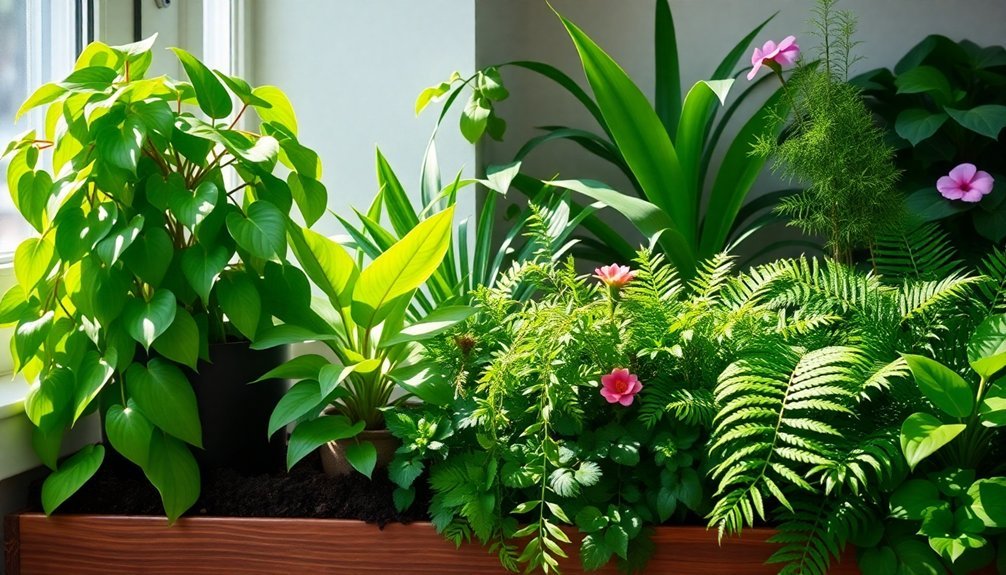
While a single houseplant can help purify your indoor air, the science behind plant grouping reveals a powerful multiplier effect.
When you cluster plants together, they work synergistically to improve indoor air quality at a rate that's considerably higher than individual plants working alone.
Research shows that plants can clean your air more effectively in groups, with NASA recommending 15-18 plants for an 1,800-square-foot space.
When VOCs are present, multiple plants collaborate with soil microorganisms to enhance their air-purifying abilities.
You'll also benefit from their collective transpiration, which naturally increases humidity and helps trap airborne pollutants.
While studies suggest you'd need 10-1,000 plants per square meter for maximum air purification, even smaller groupings can make a noticeable difference in your indoor environment.
Synergistic Benefits of Multiple Plant Species
When you combine different indoor plant species, you'll create a more powerful air-purifying system since each plant targets specific pollutants and VOCs.
The collaborative effect of multiple species goes beyond air filtration, as plants work together to maintain beneficial soil conditions and support helpful microorganisms.
Your indoor air quality improves considerably with a diverse collection of 15-18 plants per 1,800 square feet, as the varied leaf structures and natural processes complement each other to create a healthier environment.
Species Diversity Enhances Purification
Just as a diverse ecosystem thrives better than a monoculture, combining different indoor plant species creates a more powerful air-purifying system than using a single type.
You'll find that species diversity maximizes air purification because each plant tackles specific pollutants differently. Some plants excel at removing formaldehyde, while others target benzene or trichloroethylene.
When you combine multiple plant varieties, you'll achieve a higher clean air delivery rate and more effective VOCs reduction.
Your indoor environment benefits from the complementary abilities of different plants working together, creating a balanced microclimate with ideal humidity levels.
You'll also notice better adaptation to varying conditions, as different species can maintain their purifying effects across changing light and temperature levels throughout your space.
Plants Support Each Other
Similar to how plants thrive together in nature, indoor plant species form mutually beneficial relationships that enhance their collective air-purifying abilities.
When plants support each other in an indoor environment, they create a synergistic environment that maximizes air purification efficiency. You'll notice better results when combining plants with different leaf structures and sizes, as they work together to capture more light and absorb various pollutants.
Your indoor plants will collaborate to improve humidity levels and foster healthier soil microbes, leading to more effective pollutant breakdown.
Optimal Plant Combinations for Air Filtration
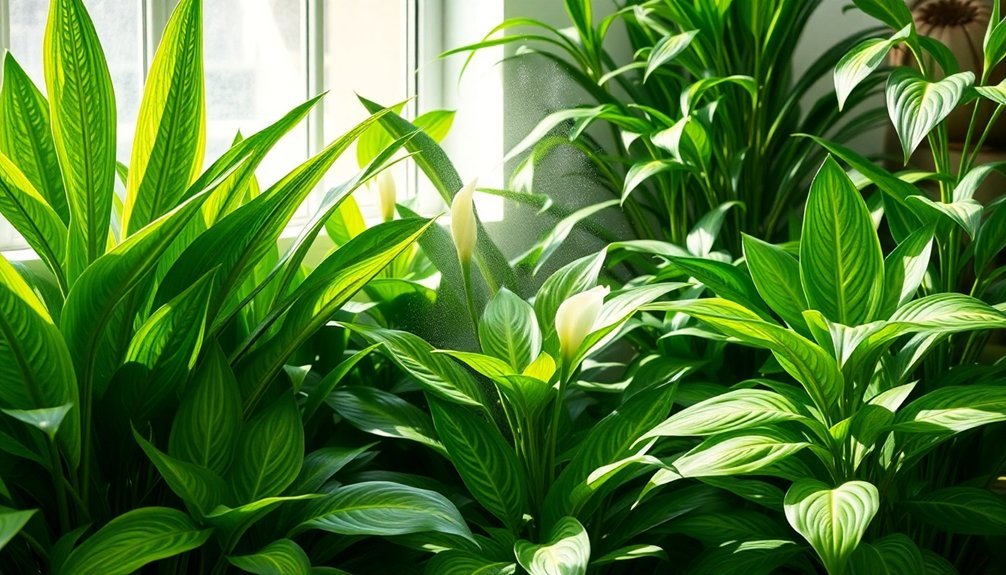
To maximize your indoor air purification efforts, strategic plant combinations can create a powerful natural filtration system. By selecting multiple plant species that target different indoor pollutants, you'll establish a more thorough air cleaning approach. You'll want to maintain proper humidity levels by grouping plants together, which creates beneficial microenvironments.
| Plant Type | Primary Pollutant Removed |
|---|---|
| Spider Plant | Formaldehyde |
| Peace Lily | Benzene |
| Snake Plant | Trichloroethylene |
| Bamboo Palm | Multiple VOCs |
For an 1,800-square-foot home, you'll need 15-18 well-maintained plants in 6-8 inch containers. Remember that healthy plants work harder at air purification, so proper care is essential. By combining these plants strategically, you're not just filtering air – you're creating a balanced ecosystem that supports better indoor air quality.
Space Requirements for Maximum Impact
While many people assume a few potted plants will purify their indoor air, research reveals that effective air filtration requires careful space planning and a substantial number of plants.
To reduce indoor air pollutants effectively, you'll need between 10 to 1,000 plants per square meter, which means a typical 1,000-square-foot home would require thousands of plants for meaningful impact.
NASA's guidelines suggest that to improve air quality inside your home, you should place 15-18 robust houseplants in 6-8 inch containers for every 1,800 square feet.
When planning your indoor garden, remember that larger, thriving plants reduce indoor air pollutants more efficiently than smaller ones.
Since plants' air-cleaning rates are slower than typical home air exchange rates, you'll need to strategically position multiple houseplants throughout your space for best results.
Humidity Zones Created by Plant Clusters
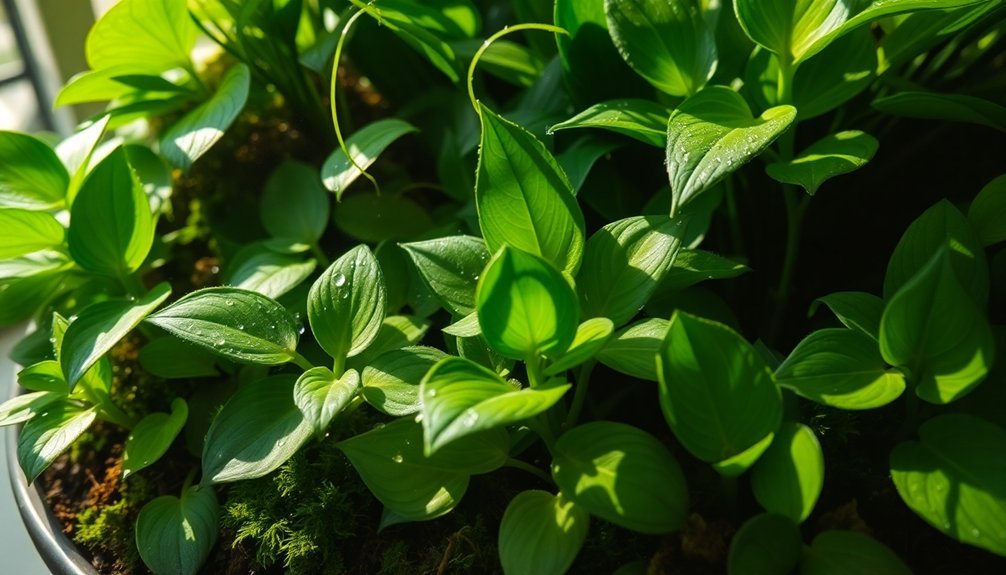
You'll find that grouping your plants creates powerful humidity zones through their combined transpiration, naturally boosting moisture levels in specific areas of your home.
Your clustered plants work together to establish stable microclimates, where the collective moisture output maintains ideal humidity levels between 40-65%.
Group Moisture Distribution Patterns
When indoor plants are grouped together, they create beneficial humidity zones through their collective transpiration process.
You'll notice how these group moisture distribution patterns work together to maintain consistent humidity levels throughout your space.
As your plants release moisture through their leaves, they form a microclimate that helps combat dry indoor air.
Clustered Transpiration Benefits
Three distinct benefits emerge when clustering indoor plants together for humidity control.
First, you'll experience enhanced humidity levels as clustered plants work together, releasing up to 97% of their absorbed water through transpiration.
Second, you're creating beneficial microclimates that stabilize temperature variations while maintaining ideal moisture levels between 40% and 65%.
Finally, you'll notice improved air quality through the combined effect of multiple plants working in harmony.
When you group plants together, their collective transpiration creates humidity zones that are more effective than single plants working alone. This clustering strategy helps prevent respiratory issues and reduces mold risks, making your indoor environment healthier.
The synergistic effect of grouped plants guarantees a more consistent and substantial impact on your home's overall moisture balance.
Localized Humidity Control
Creating localized humidity zones through strategic plant clustering offers precise moisture control in specific areas of your home. You'll notice improved respiratory health as these plant groups work together to release moisture through transpiration, naturally humidifying your space.
| Plant Location | Benefits |
|---|---|
| Living Room | Enhanced air moisture levels |
| Home Office | Improved productivity zone |
| Bedroom | Better sleep environment |
| Kitchen | Balanced humidity control |
The synergistic effect of multiple plants creates microenvironments where moisture levels remain consistently higher than surrounding areas. This natural humidification is particularly valuable in modern, energy-efficient homes where indoor air can become too dry. By arranging different plant species together, you're establishing varying transpiration rates that contribute to a more balanced and comfortable indoor atmosphere. These moisture-rich zones help combat dry air while supporting ideal breathing conditions.
Strategic Placement of Plant Groups
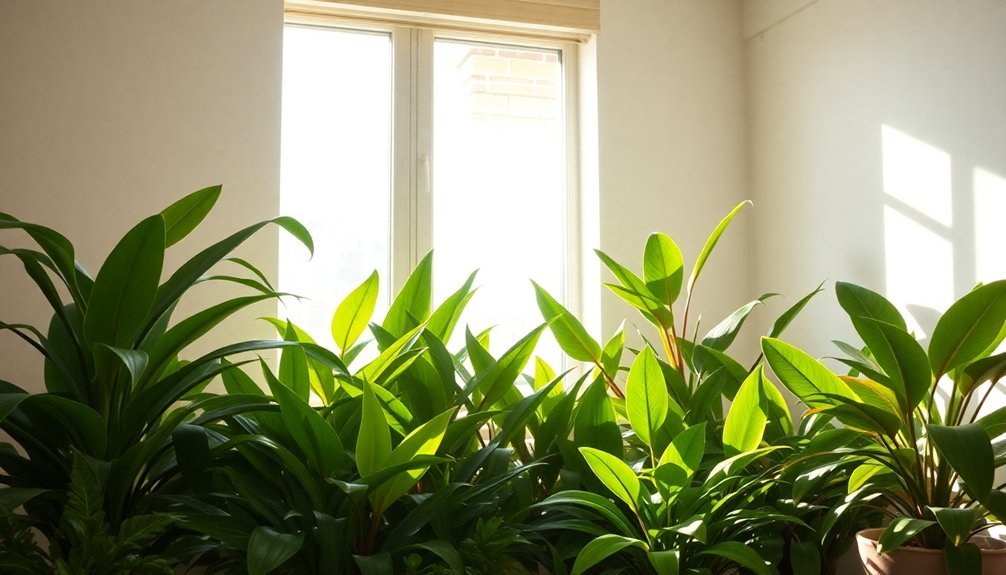
Since indoor plants work more effectively in groups, strategic placement of multiple specimens can dramatically boost their air-purifying power.
You'll want to position clusters of plants near common sources of indoor pollutants, like furniture, electronics, and household appliances, where they can efficiently capture harmful compounds such as formaldehyde and benzene.
For maximum air purification benefits, concentrate your plant groups in high-traffic areas where you spend most of your time.
While research suggests you'd need 10-1,000 plants per square meter for significant impact, you can create focused zones of improvement by clustering various plant species together.
This approach not only enhances their collective ability to filter air but also creates beneficial micro-environments with improved humidity levels that help trap airborne toxins.
Diverse Pollutant Removal Capabilities
While many indoor plants can filter air pollutants, their specific removal capabilities vary considerably by species. You'll achieve better results with a diverse collection of plants targeting different volatile organic compounds (VOCs). For example, when you combine chrysanthemums that tackle benzene with spider plants that eliminate formaldehyde, you'll increase your clean air delivery rate (CADR) and improve overall air quality more effectively.
| Plant Type | Primary Pollutant Removed | Effectiveness |
|---|---|---|
| Chrysanthemum | Benzene | High |
| Spider Plant | Formaldehyde | Very High |
| Golden Pothos | Formaldehyde | High |
| Gerbera Daisy | Benzene | Very High |
For ideal results, aim to maintain 15-18 different houseplants throughout your space. This combination approach guarantees you're targeting multiple airborne toxins simultaneously, creating a more thorough air purification system.
Growth Patterns in Multi-Plant Settings

When you group multiple plants together, they develop distinct growth patterns that enhance their collective air-purifying abilities.
You'll notice that plants in shared spaces create a beneficial microenvironment that maximizes their air purification potential. This natural synergy leads to more effective removal of volatile organic compounds and other indoor pollutants.
- Plants grow more vigorously in groups, increasing their total leaf surface area for better air filtration.
- Each plant species targets different pollutants, creating a thorough air cleaning system.
- The combined root systems promote healthy soil microorganisms that aid in breaking down airborne toxins.
- Grouped plants work together to maintain ideal humidity levels, which helps trap dust and allergens.
This cooperative growth pattern means you'll get superior air quality improvements compared to having isolated plants, making multi-plant arrangements an excellent choice for indoor spaces.
Maintenance Tips for Plant Communities
Maintaining a thriving plant community requires consistent attention to verify ideal air-purifying performance. You'll need to regularly inspect your plants indoors for pests and diseases that can compromise their air-cleaning abilities. Clean the leaves frequently to maximize their purification potential and light absorption.
| Maintenance Task | Frequency | Benefits |
|---|---|---|
| Pest Inspection | Weekly | Prevents infestation spread |
| Leaf Cleaning | Bi-weekly | Enhances air purifying |
| Watering Check | As needed | Prevents mold growth |
| Plant Grouping | Monthly | Optimizes growth conditions |
| Position Rotation | Bi-monthly | Guarantees even light exposure |
To optimize your plants' air-purifying capabilities, group them based on similar light and humidity needs. Don't forget to rotate their positions periodically, verifying each plant receives adequate light exposure. Monitor soil moisture by checking if the top inch is dry before watering again.
Seasonal Considerations for Plant Groups
As seasons shift throughout the year, your indoor plant groups require strategic adjustments to maintain their air-purifying effectiveness. The growing season dramatically impacts how well your plants filter indoor air pollutants, with peak performance during spring and summer months.
You'll need to adapt your plant care routine to accommodate seasonal changes and varying humidity levels.
- Choose ferns and peace lilies for spring and summer when natural humidity is higher, maximizing their air-cleaning capabilities.
- Switch focus to drought-tolerant plants like snake plants and ZZ plants during dry winter months.
- Increase artificial lighting during shorter winter days to support continued air purification.
- Monitor for seasonal pest issues, especially during warmer months, to maintain your plants' health and effectiveness.
Remember to rotate your plant selections based on their seasonal strengths to maintain ideal air quality year-round.
Measuring Air Quality Improvements
You'll need reliable air quality monitoring equipment to measure VOC levels and particulate matter when evaluating your indoor plants' effectiveness.
Your measurements should account for the quantity of plants, as research shows you need between 10 to 1,000 plants per square meter to achieve meaningful air quality improvements.
To get accurate readings, you'll want to track changes over time using particle detection methods while considering variables like ventilation rates and humidity levels that can affect your results.
Particle Detection Methods
When measuring how effectively indoor plants improve air quality, you'll need reliable particle detection methods to track changes in pollutant levels.
Modern technology offers several sophisticated ways to measure air quality improvements and determine the clean air delivery rate (CADR) of your indoor plants.
- High-precision sensors provide real-time monitoring of volatile organic compounds (VOCs) and particulate matter
- Gravimetric analysis weighs collected particles on specialized filters for accurate measurements
- Laser-based optical systems count and classify airborne particles instantly
- Advanced monitoring platforms track thorough air quality data before and after adding plants
These detection methods help you understand exactly how your plants are performing in real-world conditions.
While laboratory studies use controlled environments, your actual results may vary depending on factors like air circulation and the mix of pollutants present in your space.
Plant Quantity Impact Analysis
The number of indoor plants needed for meaningful air quality improvements may surprise many homeowners. Research shows you'll need between 100 to 1,000 plants per 10 square feet to achieve noticeable results.
NASA's study suggests a more manageable approach: 15 to 18 plants in 6- to 8-inch pots for an 1,800-square-foot home.
While plant quantity matters, it's important to understand their limitations. Your plants' clean air delivery rate works slower than typical home air exchange rates, making natural ventilation more effective at removing VOCs.
Though multiple plants create a cumulative effect on air quality, you'll need to balance their benefits against potential drawbacks. Be cautious not to overcrowd your space, as too many plants can increase humidity and create conditions for mold growth.
Health Benefits of Plant Clusters
Creating strategic clusters of indoor plants offers powerful health advantages beyond what single plants can provide. When you group 15-18 plants together in your living space, you'll improve air quality markedly while reducing toxins like formaldehyde and benzene.
The combined leaf surface area works more effectively to cleanse your indoor environment, supporting better respiratory health through increased humidity levels.
- Your plant clusters work together to target different pollutants, as each species specializes in removing specific toxins.
- You'll experience enhanced mood and productivity from the abundant greenery surrounding you.
- The increased humidity from multiple plants helps prevent dry air discomfort.
- Your breathing environment improves as plants collectively absorb more carbon dioxide and VOCs.
The synergistic effect of these natural air purifiers creates a healthier, more comfortable living space for you and your family.
Frequently Asked Questions
Does Having Lots of Plants Improve Air Quality?
While you'll get mood-boosting benefits from houseplants, they won't greatly improve air quality unless you add hundreds per square meter. You're better off focusing on proper ventilation and reducing pollutant sources directly.
What Plant Removes 78% of Airborne Mold?
The areca palm (Dypsis lutescens) is your best choice for fighting airborne mold – it'll remove up to 78% of mold spores. You'll want to keep it in indirect light with regular watering.
How Many Plants Do You Need in a Room to Improve Air Quality?
You'll need 15-18 houseplants in 6-8 inch pots for an 1,800-square-foot space to see modest air quality improvements. However, for significant purification, you'd actually need thousands of plants per room.
How Many Plants to Purify Air in a House?
You'll need about 15-18 houseplants for a typical 1,800 sq ft home to help purify air. While more plants offer better results, this NASA-recommended number provides a practical balance for basic air quality improvement.
In Summary
Multiple plants work better than single specimens because you'll get exponential benefits from their combined filtering power. By grouping different species, you're creating humidity zones that enhance air purification while each plant targets specific pollutants. You'll need less maintenance when plants support each other in clusters, and you can measure improved air quality through reduced toxins and increased oxygen levels in your indoor spaces.
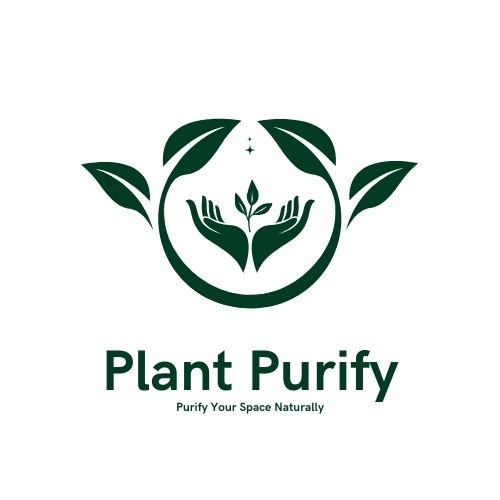



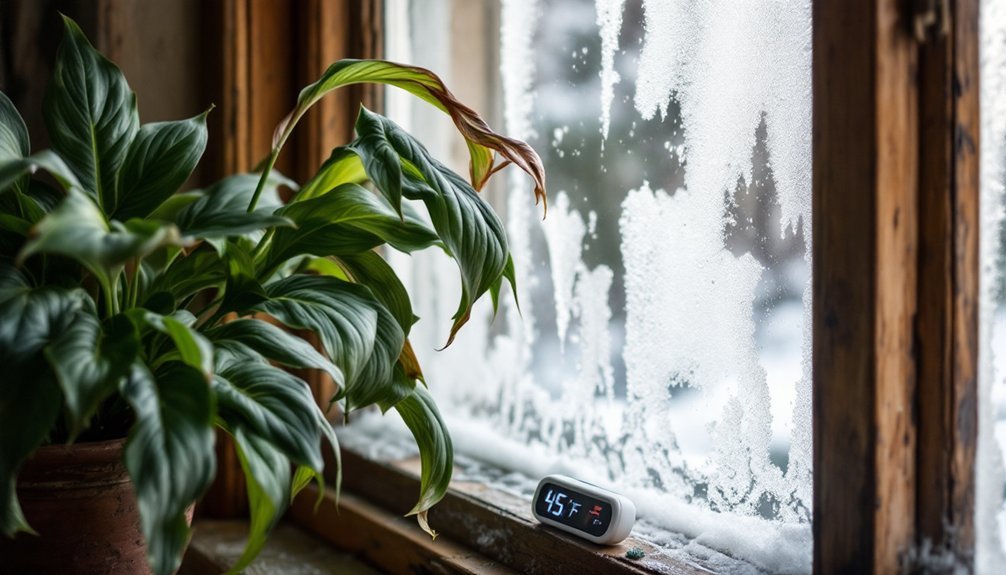
Leave a Reply